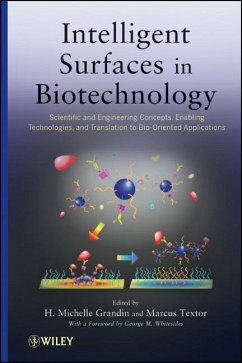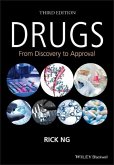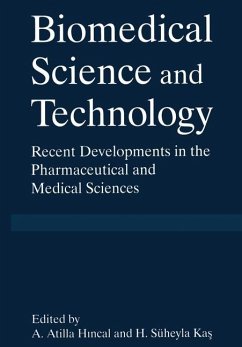Intelligent Surfaces in Biotechnology
Scientific and Engineering Concepts, Enabling Technologies, and Translation to Bio-Oriented Applications
Edited by Grandin, H. Michelle; Textor, Marcus
Intelligent Surfaces in Biotechnology
Scientific and Engineering Concepts, Enabling Technologies, and Translation to Bio-Oriented Applications
Edited by Grandin, H. Michelle; Textor, Marcus
- Gebundenes Buch
- Merkliste
- Auf die Merkliste
- Bewerten Bewerten
- Teilen
- Produkt teilen
- Produkterinnerung
- Produkterinnerung
A comprehensive overview of smart and responsive surfaces in biotechnology and their applications
A wave of recent advances in cell biology, biophysics, chemistry, and materials science has enabled the development of a new generation of smart biomaterials. Intelligent Surfaces in Biotechnology: Scientific and Engineering Concepts, Enabling Technologies, and Translation to Bio-Oriented Applications provides readers with a comprehensive overview of surface modifications and their applications, including coverage of the physico-chemical properties, characterization methods, smart coating…mehr
Andere Kunden interessierten sich auch für
![Drugs Drugs]() Rick NgDrugs109,99 €
Rick NgDrugs109,99 €![Medicines from Animal Cell Culture Medicines from Animal Cell Culture]() Glyn Stacey / John Davis (Hgg.)Medicines from Animal Cell Culture469,99 €
Glyn Stacey / John Davis (Hgg.)Medicines from Animal Cell Culture469,99 €![Quality Systems and Controls for Pharmaceuticals Quality Systems and Controls for Pharmaceuticals]() Dipak Kumar SarkarQuality Systems and Controls for Pharmaceuticals86,99 €
Dipak Kumar SarkarQuality Systems and Controls for Pharmaceuticals86,99 €![Biofilm Eradication and Prevention Biofilm Eradication and Prevention]() Tamilvanan ShunmugaperumalBiofilm Eradication and Prevention223,99 €
Tamilvanan ShunmugaperumalBiofilm Eradication and Prevention223,99 €![Hot-Melt Extrusion Hot-Melt Extrusion]() Dennis DouroumisHot-Melt Extrusion197,99 €
Dennis DouroumisHot-Melt Extrusion197,99 €![Model Organisms in Drug Discovery Model Organisms in Drug Discovery]() Pamela CarrollModel Organisms in Drug Discovery258,99 €
Pamela CarrollModel Organisms in Drug Discovery258,99 €![Biomedical Science and Technology Biomedical Science and Technology]() Biomedical Science and Technology41,99 €
Biomedical Science and Technology41,99 €-
-
-
A comprehensive overview of smart and responsive surfaces in biotechnology and their applications
A wave of recent advances in cell biology, biophysics, chemistry, and materials science has enabled the development of a new generation of smart biomaterials. Intelligent Surfaces in Biotechnology: Scientific and Engineering Concepts, Enabling Technologies, and Translation to Bio-Oriented Applications provides readers with a comprehensive overview of surface modifications and their applications, including coverage of the physico-chemical properties, characterization methods, smart coating technologies, and demonstration of performance in vitro and in vivo.
The first part of the book covers applications in the fields of biosensing and biodiagnostics, while the second part focuses more on coatings for medical devices, drug delivery, and tailored cell-surface interactions. The book explores intelligent surface applications such as tissue engineering, drug targeting and delivery, wound healing and anti-infection strategies, biosensors, nanopatterning, and bioinspired design of novel responsive materials and multifunctional surfaces.
Designed to aid scientists and engineers in understanding the rapidly developing field of biofunctional surfaces, Intelligent Surfaces in Biotechnology is an edited volume with each chapter written by a respected expert and featuring examples taken from the most state-of-the-art developments in the discipline.
Cover Image: Design concept for a diagnostic microfluidic system based on responsive polymer- and antibody-conjugated nanobeads (see Chapter 2 of this book, Figure 2.5; reproduced by permission from the Royal Society of Chemistry).
Hinweis: Dieser Artikel kann nur an eine deutsche Lieferadresse ausgeliefert werden.
A wave of recent advances in cell biology, biophysics, chemistry, and materials science has enabled the development of a new generation of smart biomaterials. Intelligent Surfaces in Biotechnology: Scientific and Engineering Concepts, Enabling Technologies, and Translation to Bio-Oriented Applications provides readers with a comprehensive overview of surface modifications and their applications, including coverage of the physico-chemical properties, characterization methods, smart coating technologies, and demonstration of performance in vitro and in vivo.
The first part of the book covers applications in the fields of biosensing and biodiagnostics, while the second part focuses more on coatings for medical devices, drug delivery, and tailored cell-surface interactions. The book explores intelligent surface applications such as tissue engineering, drug targeting and delivery, wound healing and anti-infection strategies, biosensors, nanopatterning, and bioinspired design of novel responsive materials and multifunctional surfaces.
Designed to aid scientists and engineers in understanding the rapidly developing field of biofunctional surfaces, Intelligent Surfaces in Biotechnology is an edited volume with each chapter written by a respected expert and featuring examples taken from the most state-of-the-art developments in the discipline.
Cover Image: Design concept for a diagnostic microfluidic system based on responsive polymer- and antibody-conjugated nanobeads (see Chapter 2 of this book, Figure 2.5; reproduced by permission from the Royal Society of Chemistry).
Hinweis: Dieser Artikel kann nur an eine deutsche Lieferadresse ausgeliefert werden.
Produktdetails
- Produktdetails
- Verlag: Wiley & Sons
- Artikelnr. des Verlages: 14553650000
- 1. Auflage
- Seitenzahl: 400
- Erscheinungstermin: 28. Februar 2012
- Englisch
- Abmessung: 241mm x 162mm x 28mm
- Gewicht: 740g
- ISBN-13: 9780470536506
- ISBN-10: 0470536500
- Artikelnr.: 34160044
- Herstellerkennzeichnung
- Libri GmbH
- Europaallee 1
- 36244 Bad Hersfeld
- gpsr@libri.de
- Verlag: Wiley & Sons
- Artikelnr. des Verlages: 14553650000
- 1. Auflage
- Seitenzahl: 400
- Erscheinungstermin: 28. Februar 2012
- Englisch
- Abmessung: 241mm x 162mm x 28mm
- Gewicht: 740g
- ISBN-13: 9780470536506
- ISBN-10: 0470536500
- Artikelnr.: 34160044
- Herstellerkennzeichnung
- Libri GmbH
- Europaallee 1
- 36244 Bad Hersfeld
- gpsr@libri.de
H. Michelle Grandin currently works as a scientific writer and consultant in the field of tissue regeneration and implant surfaces for dental applications. Previously, she worked as a senior research scientist in the biointerface group of Marcus Textor at ETH Zurich. There, she developed a waveguide fluorescence microscope for the study of bio-interactions in the near-field as well as leading a group in the development of 3D single cellular microwell arrays for application in stem cell and cancer research. Marcus Textor is a Professor Emeritus at ETH Zurich, Department of Materials. He was head of a research group dedicated to surfaces and interfaces in bio-related fields of material science. His research interests cover both fundamental aspects of the behavior of materials in contact with biological milieus and the design and development of surfaces that elicit biospecific responses.
Foreword xv
Preface xix
Contributors xxiii
1. Stimulus-Responsive Polymers as Intelligent Coatings for Biosensors:
Architectures, Response Mechanisms, and Applications 1
Vinalia Tjong, Jianming Zhang, Ashutosh Chilkoti, and Stefan Zauscher
1.1 Introduction 1
1.2 SRP Architectures for Biosensor Applications 2
1.2.1 Cross-Linked Polymer Networks (Hydrogels) 2
1.2.2 End-Grafted Polymer Chains (Polymer Brushes) 5
1.2.3 Self-Assembled Polyelectrolyte (PEL) Multilayers (LBL Thin Films) 5
1.2.4 Molecularly Imprinted Polymers 6
1.2.5 Hybrid Coatings 6
1.3 Mechanisms of Response 6
1.3.1 Sensing Selectivity 6
1.3.2 Conformational Reorganization of SRP Coatings 7
1.3.2.1 Changes in Osmotic Swelling Pressure 7
1.3.2.2 Changes in Apparent Cross-Link Density 8
1.4 Sensing and Transduction Mechanisms 9
1.4.1 Optical Transduction 9
1.4.1.1 Examples of SRP Sensors That Use Optical Transduction Principles 11
1.4.2 Electrochemical Transduction 14
1.4.2.1 Examples of SRP Sensors That Use Electrochemical Transduction
Principles 15
1.4.3 Mechanical Transduction 17
1.4.3.1 Examples of SRP Sensors That Use Mechanical Transduction Principles
18
1.5 Limitations and Challenges 19
1.5.1 LOD and Sensitivity 19
1.5.2 Selectivity 20
1.5.3 Working Range 20
1.5.4 Response Time 20
1.5.5 Reliability and Long-Term Stability 21
1.6 Conclusion and Outlook 22
Acknowledgements 22
References 22
2. Smart Surfaces for Point-of-Care Diagnostics 31
Michael A. Nash, Allison L. Golden, John M. Hoffman, James J. Lai, and
Patrick S. Stayton
2.1 Introduction 31
2.1.1 POC Testing Challenges 32
2.2 Standard Methods for Biomarker Purification, Enrichment, and Detection
33
2.3 Smart Reagents for Biomarker Purification and Processing 34
2.3.1 IgG Antibody-pNIPAAm Conjugates 38
2.3.2 Single-Chain Antibody-pNIPAAm Conjugates 39
2.3.3 Nucleotide-pNIPAAm Conjugates 40
2.3.4 Magnetic Nanoparticle (mNP)-pNIPAAm Conjugates 40
2.3.5 Gold Nanoparticle (AuNP)-pNIPAAm Conjugates 42
2.4 Sample-Processing Modules for Smart Conjugate Bioassays 44
2.4.1 Grafting of pNIPAAm from Microchannel Surfaces 45
2.4.2 Grafting of pNIPAAm from Porous Membranes 48
2.4.3 Magnetic Processing Modules 51
2.5 Devices for Use in Smart Conjugate Bioassays 54
2.5.1 Lateral-Flow Immunochromatography Devices 55
2.5.2 Wicking Membrane Flow-Through Devices 56
2.5.3 Polylaminate Microfl uidic Devices 57
2.5.4 Multilayer PDMS Smart Microfl udic Devices 58
2.6 Conclusions 60
References 61
3. Design of Intelligent Surface Modifications and Optimal Liquid Handling
for Nanoscale Bioanalytical Sensors 71
Laurent Feuz, Fredrik Höök, and Erik Reimhult
3.1 Introduction 71
3.2 Orthogonal Small (Nano)-Scale Surface Modification Using Molecular
Self-Assembly 75
3.2.1 Surface Anchor: How to Define and Retain a Molecular Pattern 77
3.2.1.1 Weak Anchors: "Physisorption" 77
3.2.1.2 Strong Anchors: "Chemisorption" 79
3.2.1.3 Weak versus Strong Anchors for Nanoscale Sensors 80
3.2.2 Spacer: How to Suppress Binding 83
3.2.3 Recognizing and Capturing Analytes on an Intelligent Nanostructure 86
3.2.3.1 Antibodies 86
3.2.3.2 Antibody Fragments 87
3.2.3.3 Aptamers 87
3.2.3.4 General Considerations for Recognition Element Immobilization 87
3.3 Alternative Surface Patterning Strategies 89
3.3.1 Lithographic Patterning of Physisorbed Macromolecules 89
3.3.2 Nanoscale Molecular Surface Modification through Printing 90
3.3.3 Nanoscale Molecular Surface Modification through Direct Writing 91
3.3.4 Multivalency and the Intelligent Fluid Biointerface 92
3.3.5 Summary Functionalization of Nanoscale Biosensors 95
3.4 The Challenge of Analyte Transport 95
3.4.1 Convective versus Diffusive Flux ( jC vs. jD) 98
3.4.1.1 Scenario A ( jC = 0) 99
3.4.1.2 Scenario B ( jC = jD) 101
3.4.1.3 Scenario C ( jC > jD) 102
3.4.1.4 Summary of Scenarios A, B, and C 103
3.4.2 Reactive versus Diffusive Flux ( jR vs. jD) 106
3.4.3 Design and Operation Criteria for Efficient Mass Transport 108
3.5 Concluding Remarks 112
References 113
4. Intelligent Surfaces for Field-Effect Transistor-Based Nanobiosensing
123
Akira Matsumoto, Yuji Miyahara, and Kazunori Kataoka
4.1 Introduction 123
4.2 FET-Based Biosensors 124
4.2.1 Metal-Insulator-Semiconductor (MIS) Capacitors 124
4.2.2 Principles of bio-FETs 125
4.2.3 Ion-Sensitive Field-Effect Transistors (ISFETs) and Their Direct
Coupling with Various Biorecognition Elements as a Conventional Approach to
bio-FETs 126
4.3 Intelligent Surfaces for Signal Transduction and Amplification of
bio-FETs 128
4.3.1 CNT-Mediated Signal Transduction 128
4.3.2 SAM-Assisted Detection 129
4.3.3 Stimuli-Responsive Polymer Gel-Based Interfaces for "Debye
Length-Free" Detection 130
4.4 New Targets of bio-FETs 132
4.4.1 Carbohydrate Chain Sialic Acid (SA) Detection Using PBA SAM-Modifi ed
FETs 132
4.4.2 Scent Detection Using "Beetle/Chip" FETs 134
4.4.3 Aptamer-Modifi ed Biorecognition Surfaces for a Universal Platform of
bio-FETs 134
4.5 Future Perspective 135
References 136
5. Supported Lipid Bilayers: Intelligent Surfaces for Ion Channel
Recordings 141
Andreas Janshoff and Claudia Steinem
5.1 Introduction 141
5.2 Supported Lipid Bilayers 142
5.2.1 SSMs on Flat Interfaces 142
5.2.1.1 Lipid Bilayers on Transparent Surfaces 143
5.2.1.2 Lipid Bilayers on Gold Surfaces 143
5.2.1.3 Lipid Bilayers on Silicon 145
5.2.2 SSMs on Porous/Aperture Containing Surfaces 146
5.2.2.1 Lipid Bilayers on Micromachined Apertures 146
5.2.2.2 Lipid Bilayers on Porous Materials 147
5.2.3 Patterning of SSMs 148
5.2.3.1 Patterning of Hybrid SSMs 149
5.2.3.2 Patterning of Nonhybrid SSMs 149
5.3 Characteristics of SSMs 151
5.3.1 Thermomechanical Properties of SSMs 151
5.3.2 Mechanical Stability 154
5.4 Ion Channels in SSMs 157
5.4.1 Carriers 158
5.4.2 Channel-Forming Peptides 158
5.4.3 Channel-Forming Proteins 162
5.5 Future Perspective: Ion Channels in Micropatterned Membranes 163
References 172
6. Antimicrobial and Anti-Inflammatory Intelligent Surfaces 183
Hans J. Griesser, Heike Hall, Toby A. Jenkins, Stefani S. Griesser, and
Krasimir Vasilev
6.1 Introduction 183
6.2 Antibacterial Strategies 184
6.2.1 The Infection Problem 184
6.2.2 Approaches to Antibacterial Device Surfaces 186
6.2.3 Release of Antimicrobial Compounds from Polymers and Polymeric
Coatings 190
6.2.4 Silver-Releasing Coatings 191
6.2.5 Nonfouling Coatings 196
6.2.6 Surface-Grafted Antibacterial Molecules 196
6.3 Bioactive Antibacterial Surfaces 198
6.3.1 Established, Commercially Available Antibiotics 198
6.3.2 Experimental Antibiotics 201
6.4 Stimulus-Responsive Antibacterial Coatings for Wound Dressings 204
6.5 Anti-Infl ammatory Surfaces 208
6.5.1 The Infl ammatory Response 208
6.5.2 Contact Activation of the Complement System 209
6.5.3 Foreign Body Reaction 211
6.5.4 Anti-infl ammatory Medication 212
6.5.5 Local Prevention of the Infl ammatory
Reaction on Medical Device/Implant Surfaces 215
6.5.5.1 Prevention of Contact Activation of the Complement System 215
6.5.5.2 Prevention of the Foreign Body Reaction by Preventing Macrophage
Adhesion and Fusion 216
6.5.5.3 Prevention of Inflammation on Material Surfaces by the Release of
NO 217
6.5.5.4 Reduction of the Inflammatory Response by Increasing
Hemocompatibility 220
6.6 Conclusions and Outlook 224
References 226
7. Intelligent Polymer Thin Films and Coatings for Drug Delivery 243
Alexander N. Zelikin and Brigitte Städler
7.1 Introduction 243
7.2 Surface-Mediated Drug Delivery 246
7.2.1 Controlled Cell Adhesion and Proliferation 247
7.2.2 Small Cargo 254
7.2.3 Delivery and Presentation of Protein and Peptide Cargo 257
7.2.4 Delivery of Gene Cargo 261
7.3 Drug Delivery Vehicles with Functional Polymer Coatings 268
7.3.1 Core-Shell Particles 268
7.3.2 Polymer Capsules 271
7.4 Concluding Remarks 280
References 280
8. Micro- and Nanopatterning of Active Biomolecules and Cells 291
Daniel Aydin, Vera C. Hirschfeld-Warneken, Ilia Louban, and Joachim P.
Spatz
8.1 Introduction 291
8.2 Chemical Approaches for Protein Immobilization 291
8.3 Biomolecule Patterning by "Top-Down" Techniques 294
8.3.1 Microcontact Printing (¿CP) 294
8.3.2 Nanoimprint Lithography (NIL) 294
8.3.3 Electron Beam Lithography (EBL) 295
8.3.4 Dip-Pen Nanolithography (DPN) 295
8.4 Biomolecule Nanoarrays by Block Copolymer Nanolithography 296
8.4.1 Block Copolymer Nanolithography 297
8.4.2 Biofunctionalization of Nanostructures 299
8.4.3 Hierarchically Nanostructured Biomolecule Arrays 300
8.4.4 Fabrication of Nanoscale Distance Gradients 302
8.4.5 Soft Polymeric Biomolecule Arrays 303
8.5 Application of Nanostructured Surfaces to Study Cell Adhesion 305
8.5.1 Mimicking the Extracellular Environment 305
8.5.2 Nanoscale Control of Cellular Adhesion 305
8.5.3 Micro-Nanopatterns to Uncouple Local from Global Density 307
8.5.4 Nanoscale Gradients to Induce Cell Polarization and Directed
Migration 309
8.5.5 Substrate Elasticity Determines Cell Fate 311
8.6 Conclusion 313
References 313
9. Responsive Polymer Coatings for Smart Applications in Chromatography,
Drug Delivery Systems, and Cell Sheet Engineering 321
Rogério P. Pirraco, Masayuki Yamato, Yoshikatsu Akiyama, Kenichi Nagase,
Masamichi Nakayama, Alexandra P. Marques, Rui L. Reis, and Teruo Okano
9.1 Introduction 321
9.2 Temperature-Responsive Chromatography 322
9.2.1 Hydrophobic Chromatography 322
9.2.2 Ion-Exchange Chromatography 324
9.2.3 Affinity Chromatography 327
9.3 Temperature-Responsive Polymer Micelles 328
9.3.1 Temperature-Responsive Corona 329
9.3.2 Temperature-Responsive Core 332
9.4 Temperature-Responsive Culture Surfaces 333
9.4.1 Temperature-Responsive Culture Dishes 333
9.4.2 Temperature-Responsive Surfaces on Porous Substrates 336
9.4.3 Functionalization of Temperature-Responsive Surfaces 336
9.4.4 Temperature-Responsive Surface Patterning 338
9.5 Cell Sheet Engineering 339
9.5.1 Characterization of Harvested Cell Sheets 339
9.5.2 Applications in Regenerative Medicine 340
9.5.3 Thick Tissue Reconstruction 343
9.6 Conclusions 345
References 346
Index 355
Preface xix
Contributors xxiii
1. Stimulus-Responsive Polymers as Intelligent Coatings for Biosensors:
Architectures, Response Mechanisms, and Applications 1
Vinalia Tjong, Jianming Zhang, Ashutosh Chilkoti, and Stefan Zauscher
1.1 Introduction 1
1.2 SRP Architectures for Biosensor Applications 2
1.2.1 Cross-Linked Polymer Networks (Hydrogels) 2
1.2.2 End-Grafted Polymer Chains (Polymer Brushes) 5
1.2.3 Self-Assembled Polyelectrolyte (PEL) Multilayers (LBL Thin Films) 5
1.2.4 Molecularly Imprinted Polymers 6
1.2.5 Hybrid Coatings 6
1.3 Mechanisms of Response 6
1.3.1 Sensing Selectivity 6
1.3.2 Conformational Reorganization of SRP Coatings 7
1.3.2.1 Changes in Osmotic Swelling Pressure 7
1.3.2.2 Changes in Apparent Cross-Link Density 8
1.4 Sensing and Transduction Mechanisms 9
1.4.1 Optical Transduction 9
1.4.1.1 Examples of SRP Sensors That Use Optical Transduction Principles 11
1.4.2 Electrochemical Transduction 14
1.4.2.1 Examples of SRP Sensors That Use Electrochemical Transduction
Principles 15
1.4.3 Mechanical Transduction 17
1.4.3.1 Examples of SRP Sensors That Use Mechanical Transduction Principles
18
1.5 Limitations and Challenges 19
1.5.1 LOD and Sensitivity 19
1.5.2 Selectivity 20
1.5.3 Working Range 20
1.5.4 Response Time 20
1.5.5 Reliability and Long-Term Stability 21
1.6 Conclusion and Outlook 22
Acknowledgements 22
References 22
2. Smart Surfaces for Point-of-Care Diagnostics 31
Michael A. Nash, Allison L. Golden, John M. Hoffman, James J. Lai, and
Patrick S. Stayton
2.1 Introduction 31
2.1.1 POC Testing Challenges 32
2.2 Standard Methods for Biomarker Purification, Enrichment, and Detection
33
2.3 Smart Reagents for Biomarker Purification and Processing 34
2.3.1 IgG Antibody-pNIPAAm Conjugates 38
2.3.2 Single-Chain Antibody-pNIPAAm Conjugates 39
2.3.3 Nucleotide-pNIPAAm Conjugates 40
2.3.4 Magnetic Nanoparticle (mNP)-pNIPAAm Conjugates 40
2.3.5 Gold Nanoparticle (AuNP)-pNIPAAm Conjugates 42
2.4 Sample-Processing Modules for Smart Conjugate Bioassays 44
2.4.1 Grafting of pNIPAAm from Microchannel Surfaces 45
2.4.2 Grafting of pNIPAAm from Porous Membranes 48
2.4.3 Magnetic Processing Modules 51
2.5 Devices for Use in Smart Conjugate Bioassays 54
2.5.1 Lateral-Flow Immunochromatography Devices 55
2.5.2 Wicking Membrane Flow-Through Devices 56
2.5.3 Polylaminate Microfl uidic Devices 57
2.5.4 Multilayer PDMS Smart Microfl udic Devices 58
2.6 Conclusions 60
References 61
3. Design of Intelligent Surface Modifications and Optimal Liquid Handling
for Nanoscale Bioanalytical Sensors 71
Laurent Feuz, Fredrik Höök, and Erik Reimhult
3.1 Introduction 71
3.2 Orthogonal Small (Nano)-Scale Surface Modification Using Molecular
Self-Assembly 75
3.2.1 Surface Anchor: How to Define and Retain a Molecular Pattern 77
3.2.1.1 Weak Anchors: "Physisorption" 77
3.2.1.2 Strong Anchors: "Chemisorption" 79
3.2.1.3 Weak versus Strong Anchors for Nanoscale Sensors 80
3.2.2 Spacer: How to Suppress Binding 83
3.2.3 Recognizing and Capturing Analytes on an Intelligent Nanostructure 86
3.2.3.1 Antibodies 86
3.2.3.2 Antibody Fragments 87
3.2.3.3 Aptamers 87
3.2.3.4 General Considerations for Recognition Element Immobilization 87
3.3 Alternative Surface Patterning Strategies 89
3.3.1 Lithographic Patterning of Physisorbed Macromolecules 89
3.3.2 Nanoscale Molecular Surface Modification through Printing 90
3.3.3 Nanoscale Molecular Surface Modification through Direct Writing 91
3.3.4 Multivalency and the Intelligent Fluid Biointerface 92
3.3.5 Summary Functionalization of Nanoscale Biosensors 95
3.4 The Challenge of Analyte Transport 95
3.4.1 Convective versus Diffusive Flux ( jC vs. jD) 98
3.4.1.1 Scenario A ( jC = 0) 99
3.4.1.2 Scenario B ( jC = jD) 101
3.4.1.3 Scenario C ( jC > jD) 102
3.4.1.4 Summary of Scenarios A, B, and C 103
3.4.2 Reactive versus Diffusive Flux ( jR vs. jD) 106
3.4.3 Design and Operation Criteria for Efficient Mass Transport 108
3.5 Concluding Remarks 112
References 113
4. Intelligent Surfaces for Field-Effect Transistor-Based Nanobiosensing
123
Akira Matsumoto, Yuji Miyahara, and Kazunori Kataoka
4.1 Introduction 123
4.2 FET-Based Biosensors 124
4.2.1 Metal-Insulator-Semiconductor (MIS) Capacitors 124
4.2.2 Principles of bio-FETs 125
4.2.3 Ion-Sensitive Field-Effect Transistors (ISFETs) and Their Direct
Coupling with Various Biorecognition Elements as a Conventional Approach to
bio-FETs 126
4.3 Intelligent Surfaces for Signal Transduction and Amplification of
bio-FETs 128
4.3.1 CNT-Mediated Signal Transduction 128
4.3.2 SAM-Assisted Detection 129
4.3.3 Stimuli-Responsive Polymer Gel-Based Interfaces for "Debye
Length-Free" Detection 130
4.4 New Targets of bio-FETs 132
4.4.1 Carbohydrate Chain Sialic Acid (SA) Detection Using PBA SAM-Modifi ed
FETs 132
4.4.2 Scent Detection Using "Beetle/Chip" FETs 134
4.4.3 Aptamer-Modifi ed Biorecognition Surfaces for a Universal Platform of
bio-FETs 134
4.5 Future Perspective 135
References 136
5. Supported Lipid Bilayers: Intelligent Surfaces for Ion Channel
Recordings 141
Andreas Janshoff and Claudia Steinem
5.1 Introduction 141
5.2 Supported Lipid Bilayers 142
5.2.1 SSMs on Flat Interfaces 142
5.2.1.1 Lipid Bilayers on Transparent Surfaces 143
5.2.1.2 Lipid Bilayers on Gold Surfaces 143
5.2.1.3 Lipid Bilayers on Silicon 145
5.2.2 SSMs on Porous/Aperture Containing Surfaces 146
5.2.2.1 Lipid Bilayers on Micromachined Apertures 146
5.2.2.2 Lipid Bilayers on Porous Materials 147
5.2.3 Patterning of SSMs 148
5.2.3.1 Patterning of Hybrid SSMs 149
5.2.3.2 Patterning of Nonhybrid SSMs 149
5.3 Characteristics of SSMs 151
5.3.1 Thermomechanical Properties of SSMs 151
5.3.2 Mechanical Stability 154
5.4 Ion Channels in SSMs 157
5.4.1 Carriers 158
5.4.2 Channel-Forming Peptides 158
5.4.3 Channel-Forming Proteins 162
5.5 Future Perspective: Ion Channels in Micropatterned Membranes 163
References 172
6. Antimicrobial and Anti-Inflammatory Intelligent Surfaces 183
Hans J. Griesser, Heike Hall, Toby A. Jenkins, Stefani S. Griesser, and
Krasimir Vasilev
6.1 Introduction 183
6.2 Antibacterial Strategies 184
6.2.1 The Infection Problem 184
6.2.2 Approaches to Antibacterial Device Surfaces 186
6.2.3 Release of Antimicrobial Compounds from Polymers and Polymeric
Coatings 190
6.2.4 Silver-Releasing Coatings 191
6.2.5 Nonfouling Coatings 196
6.2.6 Surface-Grafted Antibacterial Molecules 196
6.3 Bioactive Antibacterial Surfaces 198
6.3.1 Established, Commercially Available Antibiotics 198
6.3.2 Experimental Antibiotics 201
6.4 Stimulus-Responsive Antibacterial Coatings for Wound Dressings 204
6.5 Anti-Infl ammatory Surfaces 208
6.5.1 The Infl ammatory Response 208
6.5.2 Contact Activation of the Complement System 209
6.5.3 Foreign Body Reaction 211
6.5.4 Anti-infl ammatory Medication 212
6.5.5 Local Prevention of the Infl ammatory
Reaction on Medical Device/Implant Surfaces 215
6.5.5.1 Prevention of Contact Activation of the Complement System 215
6.5.5.2 Prevention of the Foreign Body Reaction by Preventing Macrophage
Adhesion and Fusion 216
6.5.5.3 Prevention of Inflammation on Material Surfaces by the Release of
NO 217
6.5.5.4 Reduction of the Inflammatory Response by Increasing
Hemocompatibility 220
6.6 Conclusions and Outlook 224
References 226
7. Intelligent Polymer Thin Films and Coatings for Drug Delivery 243
Alexander N. Zelikin and Brigitte Städler
7.1 Introduction 243
7.2 Surface-Mediated Drug Delivery 246
7.2.1 Controlled Cell Adhesion and Proliferation 247
7.2.2 Small Cargo 254
7.2.3 Delivery and Presentation of Protein and Peptide Cargo 257
7.2.4 Delivery of Gene Cargo 261
7.3 Drug Delivery Vehicles with Functional Polymer Coatings 268
7.3.1 Core-Shell Particles 268
7.3.2 Polymer Capsules 271
7.4 Concluding Remarks 280
References 280
8. Micro- and Nanopatterning of Active Biomolecules and Cells 291
Daniel Aydin, Vera C. Hirschfeld-Warneken, Ilia Louban, and Joachim P.
Spatz
8.1 Introduction 291
8.2 Chemical Approaches for Protein Immobilization 291
8.3 Biomolecule Patterning by "Top-Down" Techniques 294
8.3.1 Microcontact Printing (¿CP) 294
8.3.2 Nanoimprint Lithography (NIL) 294
8.3.3 Electron Beam Lithography (EBL) 295
8.3.4 Dip-Pen Nanolithography (DPN) 295
8.4 Biomolecule Nanoarrays by Block Copolymer Nanolithography 296
8.4.1 Block Copolymer Nanolithography 297
8.4.2 Biofunctionalization of Nanostructures 299
8.4.3 Hierarchically Nanostructured Biomolecule Arrays 300
8.4.4 Fabrication of Nanoscale Distance Gradients 302
8.4.5 Soft Polymeric Biomolecule Arrays 303
8.5 Application of Nanostructured Surfaces to Study Cell Adhesion 305
8.5.1 Mimicking the Extracellular Environment 305
8.5.2 Nanoscale Control of Cellular Adhesion 305
8.5.3 Micro-Nanopatterns to Uncouple Local from Global Density 307
8.5.4 Nanoscale Gradients to Induce Cell Polarization and Directed
Migration 309
8.5.5 Substrate Elasticity Determines Cell Fate 311
8.6 Conclusion 313
References 313
9. Responsive Polymer Coatings for Smart Applications in Chromatography,
Drug Delivery Systems, and Cell Sheet Engineering 321
Rogério P. Pirraco, Masayuki Yamato, Yoshikatsu Akiyama, Kenichi Nagase,
Masamichi Nakayama, Alexandra P. Marques, Rui L. Reis, and Teruo Okano
9.1 Introduction 321
9.2 Temperature-Responsive Chromatography 322
9.2.1 Hydrophobic Chromatography 322
9.2.2 Ion-Exchange Chromatography 324
9.2.3 Affinity Chromatography 327
9.3 Temperature-Responsive Polymer Micelles 328
9.3.1 Temperature-Responsive Corona 329
9.3.2 Temperature-Responsive Core 332
9.4 Temperature-Responsive Culture Surfaces 333
9.4.1 Temperature-Responsive Culture Dishes 333
9.4.2 Temperature-Responsive Surfaces on Porous Substrates 336
9.4.3 Functionalization of Temperature-Responsive Surfaces 336
9.4.4 Temperature-Responsive Surface Patterning 338
9.5 Cell Sheet Engineering 339
9.5.1 Characterization of Harvested Cell Sheets 339
9.5.2 Applications in Regenerative Medicine 340
9.5.3 Thick Tissue Reconstruction 343
9.6 Conclusions 345
References 346
Index 355
Foreword xv
Preface xix
Contributors xxiii
1. Stimulus-Responsive Polymers as Intelligent Coatings for Biosensors:
Architectures, Response Mechanisms, and Applications 1
Vinalia Tjong, Jianming Zhang, Ashutosh Chilkoti, and Stefan Zauscher
1.1 Introduction 1
1.2 SRP Architectures for Biosensor Applications 2
1.2.1 Cross-Linked Polymer Networks (Hydrogels) 2
1.2.2 End-Grafted Polymer Chains (Polymer Brushes) 5
1.2.3 Self-Assembled Polyelectrolyte (PEL) Multilayers (LBL Thin Films) 5
1.2.4 Molecularly Imprinted Polymers 6
1.2.5 Hybrid Coatings 6
1.3 Mechanisms of Response 6
1.3.1 Sensing Selectivity 6
1.3.2 Conformational Reorganization of SRP Coatings 7
1.3.2.1 Changes in Osmotic Swelling Pressure 7
1.3.2.2 Changes in Apparent Cross-Link Density 8
1.4 Sensing and Transduction Mechanisms 9
1.4.1 Optical Transduction 9
1.4.1.1 Examples of SRP Sensors That Use Optical Transduction Principles 11
1.4.2 Electrochemical Transduction 14
1.4.2.1 Examples of SRP Sensors That Use Electrochemical Transduction
Principles 15
1.4.3 Mechanical Transduction 17
1.4.3.1 Examples of SRP Sensors That Use Mechanical Transduction Principles
18
1.5 Limitations and Challenges 19
1.5.1 LOD and Sensitivity 19
1.5.2 Selectivity 20
1.5.3 Working Range 20
1.5.4 Response Time 20
1.5.5 Reliability and Long-Term Stability 21
1.6 Conclusion and Outlook 22
Acknowledgements 22
References 22
2. Smart Surfaces for Point-of-Care Diagnostics 31
Michael A. Nash, Allison L. Golden, John M. Hoffman, James J. Lai, and
Patrick S. Stayton
2.1 Introduction 31
2.1.1 POC Testing Challenges 32
2.2 Standard Methods for Biomarker Purification, Enrichment, and Detection
33
2.3 Smart Reagents for Biomarker Purification and Processing 34
2.3.1 IgG Antibody-pNIPAAm Conjugates 38
2.3.2 Single-Chain Antibody-pNIPAAm Conjugates 39
2.3.3 Nucleotide-pNIPAAm Conjugates 40
2.3.4 Magnetic Nanoparticle (mNP)-pNIPAAm Conjugates 40
2.3.5 Gold Nanoparticle (AuNP)-pNIPAAm Conjugates 42
2.4 Sample-Processing Modules for Smart Conjugate Bioassays 44
2.4.1 Grafting of pNIPAAm from Microchannel Surfaces 45
2.4.2 Grafting of pNIPAAm from Porous Membranes 48
2.4.3 Magnetic Processing Modules 51
2.5 Devices for Use in Smart Conjugate Bioassays 54
2.5.1 Lateral-Flow Immunochromatography Devices 55
2.5.2 Wicking Membrane Flow-Through Devices 56
2.5.3 Polylaminate Microfl uidic Devices 57
2.5.4 Multilayer PDMS Smart Microfl udic Devices 58
2.6 Conclusions 60
References 61
3. Design of Intelligent Surface Modifications and Optimal Liquid Handling
for Nanoscale Bioanalytical Sensors 71
Laurent Feuz, Fredrik Höök, and Erik Reimhult
3.1 Introduction 71
3.2 Orthogonal Small (Nano)-Scale Surface Modification Using Molecular
Self-Assembly 75
3.2.1 Surface Anchor: How to Define and Retain a Molecular Pattern 77
3.2.1.1 Weak Anchors: "Physisorption" 77
3.2.1.2 Strong Anchors: "Chemisorption" 79
3.2.1.3 Weak versus Strong Anchors for Nanoscale Sensors 80
3.2.2 Spacer: How to Suppress Binding 83
3.2.3 Recognizing and Capturing Analytes on an Intelligent Nanostructure 86
3.2.3.1 Antibodies 86
3.2.3.2 Antibody Fragments 87
3.2.3.3 Aptamers 87
3.2.3.4 General Considerations for Recognition Element Immobilization 87
3.3 Alternative Surface Patterning Strategies 89
3.3.1 Lithographic Patterning of Physisorbed Macromolecules 89
3.3.2 Nanoscale Molecular Surface Modification through Printing 90
3.3.3 Nanoscale Molecular Surface Modification through Direct Writing 91
3.3.4 Multivalency and the Intelligent Fluid Biointerface 92
3.3.5 Summary Functionalization of Nanoscale Biosensors 95
3.4 The Challenge of Analyte Transport 95
3.4.1 Convective versus Diffusive Flux ( jC vs. jD) 98
3.4.1.1 Scenario A ( jC = 0) 99
3.4.1.2 Scenario B ( jC = jD) 101
3.4.1.3 Scenario C ( jC > jD) 102
3.4.1.4 Summary of Scenarios A, B, and C 103
3.4.2 Reactive versus Diffusive Flux ( jR vs. jD) 106
3.4.3 Design and Operation Criteria for Efficient Mass Transport 108
3.5 Concluding Remarks 112
References 113
4. Intelligent Surfaces for Field-Effect Transistor-Based Nanobiosensing
123
Akira Matsumoto, Yuji Miyahara, and Kazunori Kataoka
4.1 Introduction 123
4.2 FET-Based Biosensors 124
4.2.1 Metal-Insulator-Semiconductor (MIS) Capacitors 124
4.2.2 Principles of bio-FETs 125
4.2.3 Ion-Sensitive Field-Effect Transistors (ISFETs) and Their Direct
Coupling with Various Biorecognition Elements as a Conventional Approach to
bio-FETs 126
4.3 Intelligent Surfaces for Signal Transduction and Amplification of
bio-FETs 128
4.3.1 CNT-Mediated Signal Transduction 128
4.3.2 SAM-Assisted Detection 129
4.3.3 Stimuli-Responsive Polymer Gel-Based Interfaces for "Debye
Length-Free" Detection 130
4.4 New Targets of bio-FETs 132
4.4.1 Carbohydrate Chain Sialic Acid (SA) Detection Using PBA SAM-Modifi ed
FETs 132
4.4.2 Scent Detection Using "Beetle/Chip" FETs 134
4.4.3 Aptamer-Modifi ed Biorecognition Surfaces for a Universal Platform of
bio-FETs 134
4.5 Future Perspective 135
References 136
5. Supported Lipid Bilayers: Intelligent Surfaces for Ion Channel
Recordings 141
Andreas Janshoff and Claudia Steinem
5.1 Introduction 141
5.2 Supported Lipid Bilayers 142
5.2.1 SSMs on Flat Interfaces 142
5.2.1.1 Lipid Bilayers on Transparent Surfaces 143
5.2.1.2 Lipid Bilayers on Gold Surfaces 143
5.2.1.3 Lipid Bilayers on Silicon 145
5.2.2 SSMs on Porous/Aperture Containing Surfaces 146
5.2.2.1 Lipid Bilayers on Micromachined Apertures 146
5.2.2.2 Lipid Bilayers on Porous Materials 147
5.2.3 Patterning of SSMs 148
5.2.3.1 Patterning of Hybrid SSMs 149
5.2.3.2 Patterning of Nonhybrid SSMs 149
5.3 Characteristics of SSMs 151
5.3.1 Thermomechanical Properties of SSMs 151
5.3.2 Mechanical Stability 154
5.4 Ion Channels in SSMs 157
5.4.1 Carriers 158
5.4.2 Channel-Forming Peptides 158
5.4.3 Channel-Forming Proteins 162
5.5 Future Perspective: Ion Channels in Micropatterned Membranes 163
References 172
6. Antimicrobial and Anti-Inflammatory Intelligent Surfaces 183
Hans J. Griesser, Heike Hall, Toby A. Jenkins, Stefani S. Griesser, and
Krasimir Vasilev
6.1 Introduction 183
6.2 Antibacterial Strategies 184
6.2.1 The Infection Problem 184
6.2.2 Approaches to Antibacterial Device Surfaces 186
6.2.3 Release of Antimicrobial Compounds from Polymers and Polymeric
Coatings 190
6.2.4 Silver-Releasing Coatings 191
6.2.5 Nonfouling Coatings 196
6.2.6 Surface-Grafted Antibacterial Molecules 196
6.3 Bioactive Antibacterial Surfaces 198
6.3.1 Established, Commercially Available Antibiotics 198
6.3.2 Experimental Antibiotics 201
6.4 Stimulus-Responsive Antibacterial Coatings for Wound Dressings 204
6.5 Anti-Infl ammatory Surfaces 208
6.5.1 The Infl ammatory Response 208
6.5.2 Contact Activation of the Complement System 209
6.5.3 Foreign Body Reaction 211
6.5.4 Anti-infl ammatory Medication 212
6.5.5 Local Prevention of the Infl ammatory
Reaction on Medical Device/Implant Surfaces 215
6.5.5.1 Prevention of Contact Activation of the Complement System 215
6.5.5.2 Prevention of the Foreign Body Reaction by Preventing Macrophage
Adhesion and Fusion 216
6.5.5.3 Prevention of Inflammation on Material Surfaces by the Release of
NO 217
6.5.5.4 Reduction of the Inflammatory Response by Increasing
Hemocompatibility 220
6.6 Conclusions and Outlook 224
References 226
7. Intelligent Polymer Thin Films and Coatings for Drug Delivery 243
Alexander N. Zelikin and Brigitte Städler
7.1 Introduction 243
7.2 Surface-Mediated Drug Delivery 246
7.2.1 Controlled Cell Adhesion and Proliferation 247
7.2.2 Small Cargo 254
7.2.3 Delivery and Presentation of Protein and Peptide Cargo 257
7.2.4 Delivery of Gene Cargo 261
7.3 Drug Delivery Vehicles with Functional Polymer Coatings 268
7.3.1 Core-Shell Particles 268
7.3.2 Polymer Capsules 271
7.4 Concluding Remarks 280
References 280
8. Micro- and Nanopatterning of Active Biomolecules and Cells 291
Daniel Aydin, Vera C. Hirschfeld-Warneken, Ilia Louban, and Joachim P.
Spatz
8.1 Introduction 291
8.2 Chemical Approaches for Protein Immobilization 291
8.3 Biomolecule Patterning by "Top-Down" Techniques 294
8.3.1 Microcontact Printing (¿CP) 294
8.3.2 Nanoimprint Lithography (NIL) 294
8.3.3 Electron Beam Lithography (EBL) 295
8.3.4 Dip-Pen Nanolithography (DPN) 295
8.4 Biomolecule Nanoarrays by Block Copolymer Nanolithography 296
8.4.1 Block Copolymer Nanolithography 297
8.4.2 Biofunctionalization of Nanostructures 299
8.4.3 Hierarchically Nanostructured Biomolecule Arrays 300
8.4.4 Fabrication of Nanoscale Distance Gradients 302
8.4.5 Soft Polymeric Biomolecule Arrays 303
8.5 Application of Nanostructured Surfaces to Study Cell Adhesion 305
8.5.1 Mimicking the Extracellular Environment 305
8.5.2 Nanoscale Control of Cellular Adhesion 305
8.5.3 Micro-Nanopatterns to Uncouple Local from Global Density 307
8.5.4 Nanoscale Gradients to Induce Cell Polarization and Directed
Migration 309
8.5.5 Substrate Elasticity Determines Cell Fate 311
8.6 Conclusion 313
References 313
9. Responsive Polymer Coatings for Smart Applications in Chromatography,
Drug Delivery Systems, and Cell Sheet Engineering 321
Rogério P. Pirraco, Masayuki Yamato, Yoshikatsu Akiyama, Kenichi Nagase,
Masamichi Nakayama, Alexandra P. Marques, Rui L. Reis, and Teruo Okano
9.1 Introduction 321
9.2 Temperature-Responsive Chromatography 322
9.2.1 Hydrophobic Chromatography 322
9.2.2 Ion-Exchange Chromatography 324
9.2.3 Affinity Chromatography 327
9.3 Temperature-Responsive Polymer Micelles 328
9.3.1 Temperature-Responsive Corona 329
9.3.2 Temperature-Responsive Core 332
9.4 Temperature-Responsive Culture Surfaces 333
9.4.1 Temperature-Responsive Culture Dishes 333
9.4.2 Temperature-Responsive Surfaces on Porous Substrates 336
9.4.3 Functionalization of Temperature-Responsive Surfaces 336
9.4.4 Temperature-Responsive Surface Patterning 338
9.5 Cell Sheet Engineering 339
9.5.1 Characterization of Harvested Cell Sheets 339
9.5.2 Applications in Regenerative Medicine 340
9.5.3 Thick Tissue Reconstruction 343
9.6 Conclusions 345
References 346
Index 355
Preface xix
Contributors xxiii
1. Stimulus-Responsive Polymers as Intelligent Coatings for Biosensors:
Architectures, Response Mechanisms, and Applications 1
Vinalia Tjong, Jianming Zhang, Ashutosh Chilkoti, and Stefan Zauscher
1.1 Introduction 1
1.2 SRP Architectures for Biosensor Applications 2
1.2.1 Cross-Linked Polymer Networks (Hydrogels) 2
1.2.2 End-Grafted Polymer Chains (Polymer Brushes) 5
1.2.3 Self-Assembled Polyelectrolyte (PEL) Multilayers (LBL Thin Films) 5
1.2.4 Molecularly Imprinted Polymers 6
1.2.5 Hybrid Coatings 6
1.3 Mechanisms of Response 6
1.3.1 Sensing Selectivity 6
1.3.2 Conformational Reorganization of SRP Coatings 7
1.3.2.1 Changes in Osmotic Swelling Pressure 7
1.3.2.2 Changes in Apparent Cross-Link Density 8
1.4 Sensing and Transduction Mechanisms 9
1.4.1 Optical Transduction 9
1.4.1.1 Examples of SRP Sensors That Use Optical Transduction Principles 11
1.4.2 Electrochemical Transduction 14
1.4.2.1 Examples of SRP Sensors That Use Electrochemical Transduction
Principles 15
1.4.3 Mechanical Transduction 17
1.4.3.1 Examples of SRP Sensors That Use Mechanical Transduction Principles
18
1.5 Limitations and Challenges 19
1.5.1 LOD and Sensitivity 19
1.5.2 Selectivity 20
1.5.3 Working Range 20
1.5.4 Response Time 20
1.5.5 Reliability and Long-Term Stability 21
1.6 Conclusion and Outlook 22
Acknowledgements 22
References 22
2. Smart Surfaces for Point-of-Care Diagnostics 31
Michael A. Nash, Allison L. Golden, John M. Hoffman, James J. Lai, and
Patrick S. Stayton
2.1 Introduction 31
2.1.1 POC Testing Challenges 32
2.2 Standard Methods for Biomarker Purification, Enrichment, and Detection
33
2.3 Smart Reagents for Biomarker Purification and Processing 34
2.3.1 IgG Antibody-pNIPAAm Conjugates 38
2.3.2 Single-Chain Antibody-pNIPAAm Conjugates 39
2.3.3 Nucleotide-pNIPAAm Conjugates 40
2.3.4 Magnetic Nanoparticle (mNP)-pNIPAAm Conjugates 40
2.3.5 Gold Nanoparticle (AuNP)-pNIPAAm Conjugates 42
2.4 Sample-Processing Modules for Smart Conjugate Bioassays 44
2.4.1 Grafting of pNIPAAm from Microchannel Surfaces 45
2.4.2 Grafting of pNIPAAm from Porous Membranes 48
2.4.3 Magnetic Processing Modules 51
2.5 Devices for Use in Smart Conjugate Bioassays 54
2.5.1 Lateral-Flow Immunochromatography Devices 55
2.5.2 Wicking Membrane Flow-Through Devices 56
2.5.3 Polylaminate Microfl uidic Devices 57
2.5.4 Multilayer PDMS Smart Microfl udic Devices 58
2.6 Conclusions 60
References 61
3. Design of Intelligent Surface Modifications and Optimal Liquid Handling
for Nanoscale Bioanalytical Sensors 71
Laurent Feuz, Fredrik Höök, and Erik Reimhult
3.1 Introduction 71
3.2 Orthogonal Small (Nano)-Scale Surface Modification Using Molecular
Self-Assembly 75
3.2.1 Surface Anchor: How to Define and Retain a Molecular Pattern 77
3.2.1.1 Weak Anchors: "Physisorption" 77
3.2.1.2 Strong Anchors: "Chemisorption" 79
3.2.1.3 Weak versus Strong Anchors for Nanoscale Sensors 80
3.2.2 Spacer: How to Suppress Binding 83
3.2.3 Recognizing and Capturing Analytes on an Intelligent Nanostructure 86
3.2.3.1 Antibodies 86
3.2.3.2 Antibody Fragments 87
3.2.3.3 Aptamers 87
3.2.3.4 General Considerations for Recognition Element Immobilization 87
3.3 Alternative Surface Patterning Strategies 89
3.3.1 Lithographic Patterning of Physisorbed Macromolecules 89
3.3.2 Nanoscale Molecular Surface Modification through Printing 90
3.3.3 Nanoscale Molecular Surface Modification through Direct Writing 91
3.3.4 Multivalency and the Intelligent Fluid Biointerface 92
3.3.5 Summary Functionalization of Nanoscale Biosensors 95
3.4 The Challenge of Analyte Transport 95
3.4.1 Convective versus Diffusive Flux ( jC vs. jD) 98
3.4.1.1 Scenario A ( jC = 0) 99
3.4.1.2 Scenario B ( jC = jD) 101
3.4.1.3 Scenario C ( jC > jD) 102
3.4.1.4 Summary of Scenarios A, B, and C 103
3.4.2 Reactive versus Diffusive Flux ( jR vs. jD) 106
3.4.3 Design and Operation Criteria for Efficient Mass Transport 108
3.5 Concluding Remarks 112
References 113
4. Intelligent Surfaces for Field-Effect Transistor-Based Nanobiosensing
123
Akira Matsumoto, Yuji Miyahara, and Kazunori Kataoka
4.1 Introduction 123
4.2 FET-Based Biosensors 124
4.2.1 Metal-Insulator-Semiconductor (MIS) Capacitors 124
4.2.2 Principles of bio-FETs 125
4.2.3 Ion-Sensitive Field-Effect Transistors (ISFETs) and Their Direct
Coupling with Various Biorecognition Elements as a Conventional Approach to
bio-FETs 126
4.3 Intelligent Surfaces for Signal Transduction and Amplification of
bio-FETs 128
4.3.1 CNT-Mediated Signal Transduction 128
4.3.2 SAM-Assisted Detection 129
4.3.3 Stimuli-Responsive Polymer Gel-Based Interfaces for "Debye
Length-Free" Detection 130
4.4 New Targets of bio-FETs 132
4.4.1 Carbohydrate Chain Sialic Acid (SA) Detection Using PBA SAM-Modifi ed
FETs 132
4.4.2 Scent Detection Using "Beetle/Chip" FETs 134
4.4.3 Aptamer-Modifi ed Biorecognition Surfaces for a Universal Platform of
bio-FETs 134
4.5 Future Perspective 135
References 136
5. Supported Lipid Bilayers: Intelligent Surfaces for Ion Channel
Recordings 141
Andreas Janshoff and Claudia Steinem
5.1 Introduction 141
5.2 Supported Lipid Bilayers 142
5.2.1 SSMs on Flat Interfaces 142
5.2.1.1 Lipid Bilayers on Transparent Surfaces 143
5.2.1.2 Lipid Bilayers on Gold Surfaces 143
5.2.1.3 Lipid Bilayers on Silicon 145
5.2.2 SSMs on Porous/Aperture Containing Surfaces 146
5.2.2.1 Lipid Bilayers on Micromachined Apertures 146
5.2.2.2 Lipid Bilayers on Porous Materials 147
5.2.3 Patterning of SSMs 148
5.2.3.1 Patterning of Hybrid SSMs 149
5.2.3.2 Patterning of Nonhybrid SSMs 149
5.3 Characteristics of SSMs 151
5.3.1 Thermomechanical Properties of SSMs 151
5.3.2 Mechanical Stability 154
5.4 Ion Channels in SSMs 157
5.4.1 Carriers 158
5.4.2 Channel-Forming Peptides 158
5.4.3 Channel-Forming Proteins 162
5.5 Future Perspective: Ion Channels in Micropatterned Membranes 163
References 172
6. Antimicrobial and Anti-Inflammatory Intelligent Surfaces 183
Hans J. Griesser, Heike Hall, Toby A. Jenkins, Stefani S. Griesser, and
Krasimir Vasilev
6.1 Introduction 183
6.2 Antibacterial Strategies 184
6.2.1 The Infection Problem 184
6.2.2 Approaches to Antibacterial Device Surfaces 186
6.2.3 Release of Antimicrobial Compounds from Polymers and Polymeric
Coatings 190
6.2.4 Silver-Releasing Coatings 191
6.2.5 Nonfouling Coatings 196
6.2.6 Surface-Grafted Antibacterial Molecules 196
6.3 Bioactive Antibacterial Surfaces 198
6.3.1 Established, Commercially Available Antibiotics 198
6.3.2 Experimental Antibiotics 201
6.4 Stimulus-Responsive Antibacterial Coatings for Wound Dressings 204
6.5 Anti-Infl ammatory Surfaces 208
6.5.1 The Infl ammatory Response 208
6.5.2 Contact Activation of the Complement System 209
6.5.3 Foreign Body Reaction 211
6.5.4 Anti-infl ammatory Medication 212
6.5.5 Local Prevention of the Infl ammatory
Reaction on Medical Device/Implant Surfaces 215
6.5.5.1 Prevention of Contact Activation of the Complement System 215
6.5.5.2 Prevention of the Foreign Body Reaction by Preventing Macrophage
Adhesion and Fusion 216
6.5.5.3 Prevention of Inflammation on Material Surfaces by the Release of
NO 217
6.5.5.4 Reduction of the Inflammatory Response by Increasing
Hemocompatibility 220
6.6 Conclusions and Outlook 224
References 226
7. Intelligent Polymer Thin Films and Coatings for Drug Delivery 243
Alexander N. Zelikin and Brigitte Städler
7.1 Introduction 243
7.2 Surface-Mediated Drug Delivery 246
7.2.1 Controlled Cell Adhesion and Proliferation 247
7.2.2 Small Cargo 254
7.2.3 Delivery and Presentation of Protein and Peptide Cargo 257
7.2.4 Delivery of Gene Cargo 261
7.3 Drug Delivery Vehicles with Functional Polymer Coatings 268
7.3.1 Core-Shell Particles 268
7.3.2 Polymer Capsules 271
7.4 Concluding Remarks 280
References 280
8. Micro- and Nanopatterning of Active Biomolecules and Cells 291
Daniel Aydin, Vera C. Hirschfeld-Warneken, Ilia Louban, and Joachim P.
Spatz
8.1 Introduction 291
8.2 Chemical Approaches for Protein Immobilization 291
8.3 Biomolecule Patterning by "Top-Down" Techniques 294
8.3.1 Microcontact Printing (¿CP) 294
8.3.2 Nanoimprint Lithography (NIL) 294
8.3.3 Electron Beam Lithography (EBL) 295
8.3.4 Dip-Pen Nanolithography (DPN) 295
8.4 Biomolecule Nanoarrays by Block Copolymer Nanolithography 296
8.4.1 Block Copolymer Nanolithography 297
8.4.2 Biofunctionalization of Nanostructures 299
8.4.3 Hierarchically Nanostructured Biomolecule Arrays 300
8.4.4 Fabrication of Nanoscale Distance Gradients 302
8.4.5 Soft Polymeric Biomolecule Arrays 303
8.5 Application of Nanostructured Surfaces to Study Cell Adhesion 305
8.5.1 Mimicking the Extracellular Environment 305
8.5.2 Nanoscale Control of Cellular Adhesion 305
8.5.3 Micro-Nanopatterns to Uncouple Local from Global Density 307
8.5.4 Nanoscale Gradients to Induce Cell Polarization and Directed
Migration 309
8.5.5 Substrate Elasticity Determines Cell Fate 311
8.6 Conclusion 313
References 313
9. Responsive Polymer Coatings for Smart Applications in Chromatography,
Drug Delivery Systems, and Cell Sheet Engineering 321
Rogério P. Pirraco, Masayuki Yamato, Yoshikatsu Akiyama, Kenichi Nagase,
Masamichi Nakayama, Alexandra P. Marques, Rui L. Reis, and Teruo Okano
9.1 Introduction 321
9.2 Temperature-Responsive Chromatography 322
9.2.1 Hydrophobic Chromatography 322
9.2.2 Ion-Exchange Chromatography 324
9.2.3 Affinity Chromatography 327
9.3 Temperature-Responsive Polymer Micelles 328
9.3.1 Temperature-Responsive Corona 329
9.3.2 Temperature-Responsive Core 332
9.4 Temperature-Responsive Culture Surfaces 333
9.4.1 Temperature-Responsive Culture Dishes 333
9.4.2 Temperature-Responsive Surfaces on Porous Substrates 336
9.4.3 Functionalization of Temperature-Responsive Surfaces 336
9.4.4 Temperature-Responsive Surface Patterning 338
9.5 Cell Sheet Engineering 339
9.5.1 Characterization of Harvested Cell Sheets 339
9.5.2 Applications in Regenerative Medicine 340
9.5.3 Thick Tissue Reconstruction 343
9.6 Conclusions 345
References 346
Index 355








